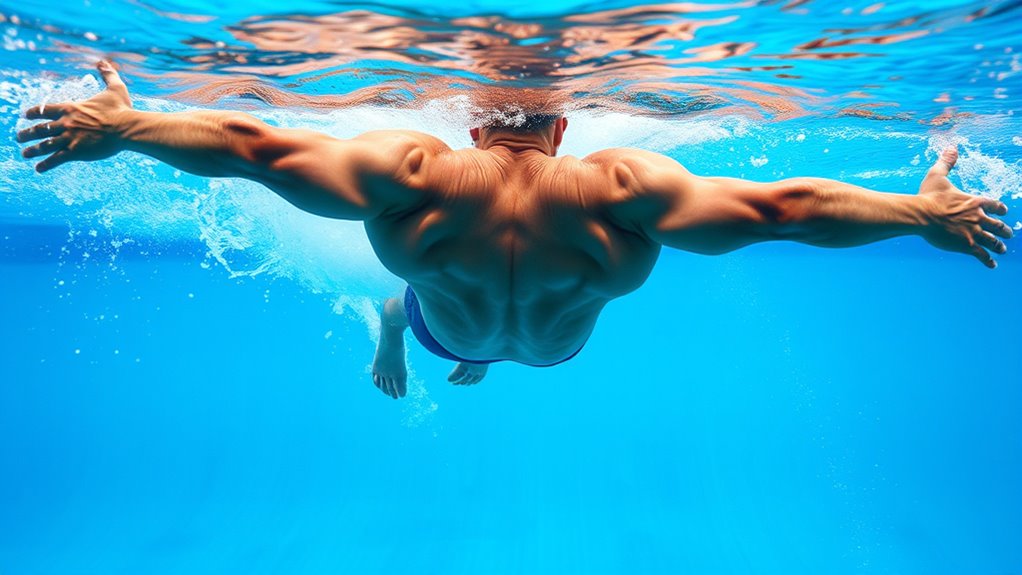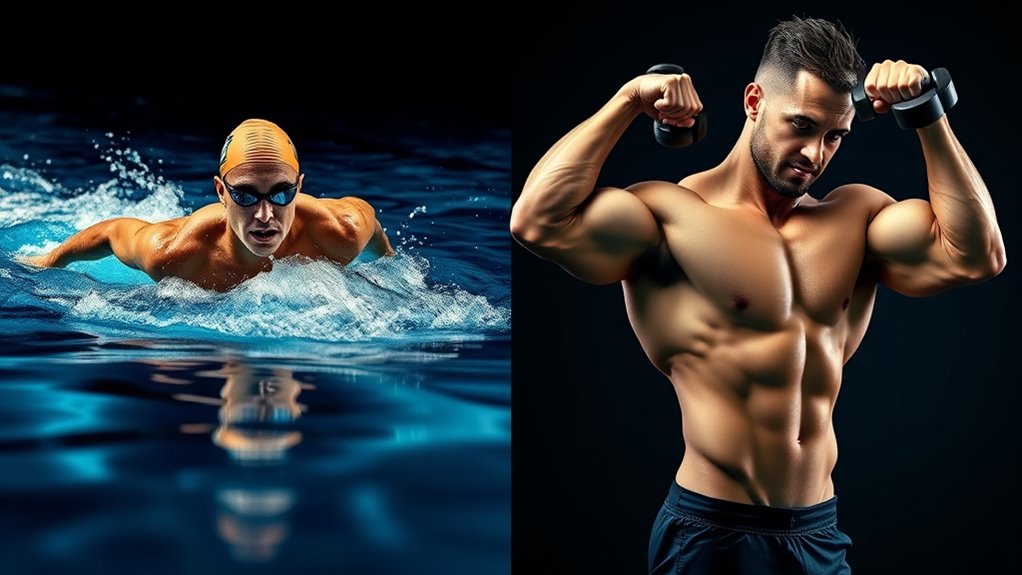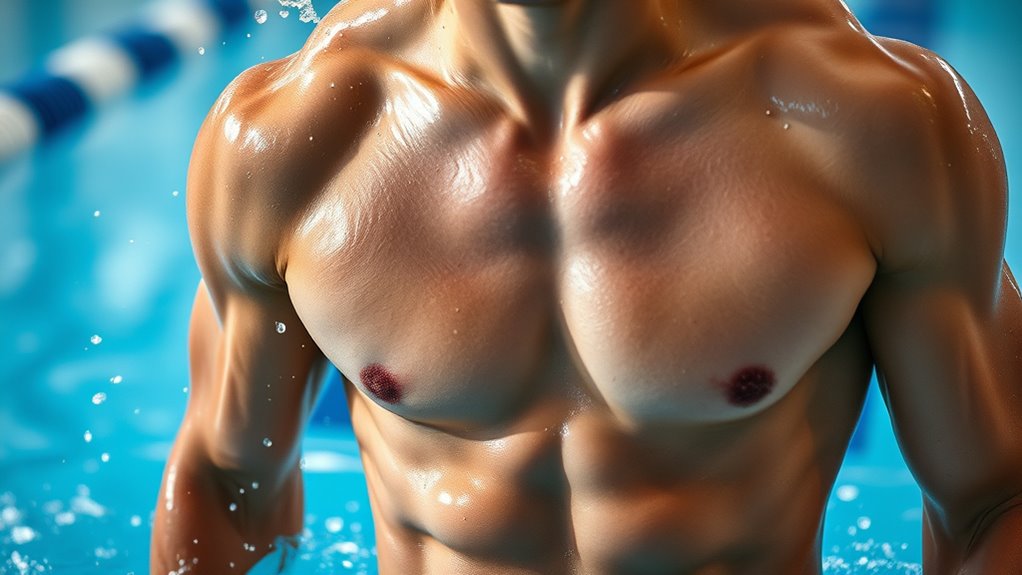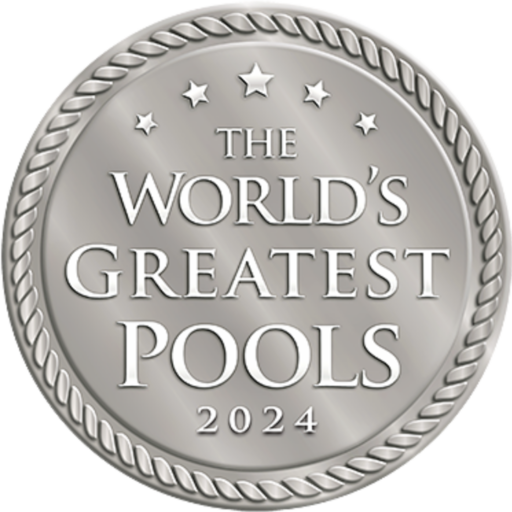Yes, swimming builds muscle, but differently than weight training. Water provides 12-14 times more resistance than air, engaging 40-50% of your total muscle mass and activating both Type I and Type IIa fibers simultaneously. You’ll develop lean, functional muscle with modest gains of 2-4%, primarily in your upper body. For ideal results, combine different strokes with HIIT protocols and proper post-workout nutrition. The following evidence-based strategies will enhance your hypertrophic adaptations in the pool.
How Swimming Activates Muscle Groups

Swimming engages multiple muscle groups simultaneously through a combination of resistance and aquatic resistance mechanics. When you move through water, you’re working against 12-14 times more resistance than air, creating natural resistance training without weights. Your muscles experience concentric contractions during the power phase of strokes and eccentric loading during recovery phases.
Different strokes target specific muscle engagement patterns: freestyle primarily activates your lats, triceps, and core; backstroke emphasizes posterior shoulder muscles and abdominals; breaststroke heavily recruits the pectorals and inner thighs; butterfly demands powerful deltoids and abdominal activation. Throughout all strokes, your core muscles continuously stabilize your body position and transfer force between upper and lower extremities, creating a thorough full-body training effect unmatched by most land exercises.
The Science of Resistance Training in Water
The unique properties of water create a specialized resistance environment that fundamentally alters muscle recruitment patterns compared to land-based training. When you swim, water resistance provides 12-14 times greater opposition than air, requiring continuous muscular engagement throughout both concentric and eccentric movement phases. This multi-directional resistance transforms simple movements into thorough muscle-building activities.
Water resistance transforms simple movements into complete muscle-building activities by demanding continuous engagement through all phases of motion.
- Water resistance increases proportionally with movement speed, allowing you to self-regulate intensity without equipment modifications
- Buoyancy effects reduce joint compression forces by 50-90%, enabling higher training volumes with decreased injury risk
- Hydrostatic pressure creates approximately 0.73 mmHg of force per centimeter depth, enhancing venous return and improving cardiovascular efficiency during muscle development
This hydrodynamic environment stimulates Type I and IIa muscle fibers simultaneously, promoting balanced muscular development while maintaining functional movement patterns.
Comparing Swimming to Traditional Strength Training

While both develop muscular fitness, swimming and traditional strength training diverge considerably in their muscle-building mechanisms and outcomes. Traditional resistance training employs progressive overload with high resistance and low repetitions, focusing on myofibrillar hypertrophy. Swimming, conversely, emphasizes muscle endurance through constant, lower-resistance movements against water’s viscosity.
Studies indicate weight training typically produces greater hypertrophy, with increases of 5-10% in muscle cross-sectional area over 8-12 weeks, compared to swimming’s 2-4%. However, swimming delivers superior cardiovascular benefits, with research showing swimmers develop greater stroke volume and VO2max improvements than weightlifters. Moreover, swimming recruits more diverse muscle groups simultaneously, enhancing neuromuscular coordination rather than isolated strength gains.
Your training choice should align with specific goals—hypertrophy demands traditional strength training, while swimming excels at developing functional muscle endurance with minimal joint stress.
Different Swimming Strokes and Their Muscle Benefits
Different swimming strokes target distinct muscle groups, making stroke selection essential for your muscle-building goals. Freestyle primarily engages your shoulders and lats, while butterfly enhances upper body activation through its demanding technique and powerful arm movements. You’ll achieve ideal muscle development by strategically rotating between strokes—incorporating freestyle for endurance, butterfly for explosive power, and breaststroke for lower body strength—within your training regimen.
Best Muscle-Building Strokes
Four primary swimming strokes offer distinct muscle-building benefits, with each emphasizing different anatomical regions through unique movement patterns. The butterfly generates maximal hypertrophic response in the deltoids, latissimus dorsi, and pectoralis major, making it superior for upper body development when proper breathing techniques are maintained. Freestyle (front crawl) provides balanced muscular recruitment while allowing ideal stroke efficiency for sustained training periods.
- Butterfly: Highest caloric expenditure (800-950/hour) with significant recruitment of core stabilizers and shoulder complex
- Breaststroke: Exceptional quadriceps and adductor development through its unique frog-kick motion
- Backstroke: Targets posterior chain muscles while minimizing cervical strain through neutral head positioning
For maximal muscular development, incorporate all four strokes in periodized training protocols, varying intensity and duration to prevent adaptation plateaus.
Stroke-Specific Muscle Targeting
Each swimming stroke activates distinct muscular pathways through unique biomechanical patterns, creating targeted hypertrophic responses throughout the body. When you execute different strokes, you’ll engage specific muscle groups through varied stroke mechanics, optimizing muscle development across multiple anatomical planes.
| Stroke | Primary Muscles | Biomechanical Advantage |
|---|---|---|
| Freestyle | Deltoids, Latissimus dorsi, Triceps | Rotational torque generation |
| Backstroke | Trapezius, Rhomboids, Hamstrings | Posterior chain integration |
| Breaststroke | Pectoralis major, Quadriceps, Gluteals | Horizontal force production |
| Butterfly | Rectus abdominis, Erector spinae, Biceps | Undulatory power transfer |
| Sidestroke | Obliques, Adductors, Serratus anterior | Asymmetrical resistance loading |
Research demonstrates that alternating between these stroke patterns improves general muscle engagement through varied resistance vectors, preventing adaptation plateaus and promoting balanced hypertrophy across complementary muscle groups.
Combining Strokes Effectively
While individual strokes target specific muscle groups, strategically combining multiple stroke patterns within a single training session creates compound hypertrophic benefits through mechanical overload variation. These stroke combinations enable simultaneous development of antagonistic muscle pairs, enhancing muscular balance and preventing overuse injuries.
Effective drills for muscle development include:
- IM (Individual Medley) pyramid sets: 4×50m progressions alternating strokes that create sequential fatigue patterns across upper/lower muscle groups
- Stroke-contrast intervals: Alternating 100m freestyle with 50m butterfly to elevate mitochondrial density through varied metabolic demands
- Pull-kick shifts: Manipulating stroke mechanics by switching between pull-focused and kick-dominant segments within 200m continuous swimming
Research indicates these structured combinations yield 18% greater muscular recruitment compared to single-stroke training, particularly in latissimus dorsi and deltoid development.
Protein Synthesis and Hypertrophy in Swimmers
Swimming engages Type I and Type II muscle fibers differently than traditional resistance training, with endurance-focused swimming primarily recruiting slow-twitch fibers while sprint swimming activates fast-twitch fibers. Your body responds to swimming’s resistance through water by initiating protein synthesis, though the hypertrophic effect is typically less pronounced than with heavy resistance training due to swimming’s emphasis on repetition rather than maximal force production. You’ll experience greater muscle development in swimming when you incorporate high-intensity intervals or use resistance equipment, creating the mechanical tension necessary to trigger significant hypertrophy.
Muscle Fiber Activation
Three distinct mechanisms drive muscle fiber activation during swimming: mechanical tension, metabolic stress, and muscle damage. When you swim, water resistance creates a unique environment for muscle fiber recruitment across different stroke patterns and intensities. Research indicates that swimming mainly activates Type I (slow-twitch) and Type IIa (intermediate) muscle fibers, enhancing muscle endurance through prolonged, repetitive contractions.
- Your body engages 40-50% of total muscle mass during freestyle swimming, activating multiple fiber types simultaneously
- Fast-twitch fiber recruitment increases greatly during sprint intervals and high-intensity sets
- Resistance provided by water creates continuous tension throughout the movement pattern, enhancing neural adaptations
The variable resistance of water makes swimming unique in how it stimulates muscle fibers, requiring coordinated activation patterns that differ from land-based exercises.
Resistance vs. Repetition
Although water provides consistent resistance, its impact on muscle protein synthesis differs fundamentally from traditional weight training. Swimming elicits mainly endurance-based hypertrophy through high-repetition contractions against moderate resistance, whereas weightlifting stimulates myofibrillar hypertrophy through high-tension, low-repetition movements.
| Parameter | Swimming | Weight Training |
|---|---|---|
| Resistance | Omnidirectional, constant | Unidirectional, variable |
| Fiber Type | Type I (slow-twitch) | Type II (fast-twitch) |
| Protein Synthesis | Mitochondrial-dominant | Myofibrillar-dominant |
Your muscle engagement during swimming depends on proper form techniques. Research indicates that untrained swimmers primarily recruit deltoids and latissimus dorsi muscles at suboptimal capacity. Advanced techniques like high-elbow catch position improve mechanical advantage, increasing pectoralis major activation by approximately 24%, enhancing protein synthesis pathways specific to aquatic resistance training.
Professional Swimmers’ Physiques: Case Studies

When examining elite-level competitive swimmers, researchers observe distinct physiological adaptations that provide compelling evidence for swimming’s muscle-building potential. Elite athletes like Michael Phelps, Caeleb Dressel, and Katie Ledecky demonstrate how specialized training regimes transform physiology to optimize performance in water.
- Michael Phelps’s physique featured a 6’7″ wingspan (4″ longer than his height), broad shoulders, and relatively short legs—anatomical advantages improved by hypertrophy in lats, deltoids, and pectoral muscles
- Female Olympic swimmers typically maintain 15-19% body fat with significant upper body development, particularly in latissimus dorsi and deltoids
- Sprint specialists like Florent Manaudou exhibit greater muscle mass concentration in posterior chain muscles compared to distance swimmers, reflecting adaptation to explosive power demands
These case studies illustrate how specific swimming disciplines produce predictable muscular development patterns.
Optimal Swimming Routines for Muscle Growth
To optimize muscular development through swimming, you’ll need to incorporate High-Intensity Interval Training (HIIT) that challenges your muscles beyond their comfort zone. Full-Body Resistance Workouts using specialized equipment like paddles and drag suits greatly increase the load on your musculature, activating more fast-twitch muscle fibers responsible for growth. Implementing Progressive Distance Loading, where you systematically increase swimming distances while maintaining power output, creates the necessary physiological stress for hypertrophic adaptations to occur.
High-Intensity Interval Training
High-intensity interval training (HIIT) represents one of the most effective swimming protocols for stimulating muscular hypertrophy and strength adaptations. When you incorporate HIIT into your aquatic regimen, you’ll experience substantial improvements in aerobic capacity while simultaneously enhancing muscle endurance. The alternating pattern of maximal effort followed by brief recovery periods creates metabolic stress that triggers anabolic signaling pathways essential for muscular development.
- Implement 30-second sprint intervals at 90-95% effort followed by 60 seconds of active recovery to optimize lactate threshold and myofibrillar protein synthesis
- Utilize variable stroke patterns (butterfly, freestyle, backstroke) within intervals to engage diverse muscle groups and prevent adaptation plateaus
- Structure progressive HIIT protocols beginning with 1:3 work-to-rest ratios, gradually advancing to 1:1 as muscular conditioning improves
Full-Body Resistance Workouts
Swimming provides exceptional full-body resistance through water’s natural properties, offering 12-14 times more resistance than air while simultaneously engaging multiple muscle groups. To enhance hypertrophy, you’ll need structured resistance routines that progressively overload muscles.
| Workout Type | Primary Muscles | Training Duration |
|---|---|---|
| Butterfly Sets | Shoulders, Chest, Core | 4x100m with 45s rest |
| Freestyle Pulls | Lats, Triceps, Traps | 6x50m with 30s rest |
| Breaststroke Drills | Quads, Pectorals, Biceps | 3x200m with 60s rest |
Water resistance increases exponentially with velocity, creating variable resistance training that adapts to your effort level. This full body engagement stimulates type II muscle fibers when swimming at 70-85% maximum effort, particularly when incorporating drag-increasing equipment like paddles and pull buoys for isolated muscle targeting.
Progressive Distance Loading
While traditional resistance training relies on progressive weight increases, progressive distance loading (PDL) in swimming applies the same hypertrophy principles through structured distance manipulation. Progressive overload occurs as you systematically increase swimming volume while maintaining intensity. This adaptation stimulus triggers muscular development when implemented strategically.
- Begin with 4-6 sets of 50-meter distance intervals at high intensity, allowing 60-90 seconds recovery between sets
- Progress to 75-meter intervals after two weeks, maintaining the same stroke technique and intensity level
- Implement a 10-15% distance increase monthly, tracking fatigue markers to prevent overtraining
PDL optimizes muscle recruitment patterns by challenging your neuromuscular system with incrementally longer work periods. Research indicates this approach stimulates both slow and fast-twitch muscle fibers when executed with proper form and consistent tempo through each distance interval.
Nutritional Requirements for Swimmers Building Muscle
To effectively support muscle development during swim training, proper nutrition becomes a critical component that many athletes overlook. Your carbohydrate intake should comprise 50-60% of total calories, with 1.4-1.8g/kg consumed 4 hours pre-workout to optimize glycogen stores that fuel high-intensity swimming efforts.
Post-exercise nutrition requires consuming 20-25g of high-quality protein within 30 minutes to initiate muscle protein synthesis. Implement hydration strategies that include consuming 5-7ml/kg of fluid 4 hours before swimming and replacing 150% of weight lost during training sessions. Monitor urine color—pale yellow indicates ideal hydration status. Furthermore, incorporate omega-3 fatty acids (1-2g daily) to reduce exercise-induced inflammation and improve recovery between training sessions.
Combining Swimming With Dry Land Training
Building significant muscle mass through swimming alone presents inherent limitations that can be overcome through strategic integration of dry land resistance training. Implementing a cross training regimen that complements your aquatic workouts enhances hypertrophic adaptations by targeting specific muscle groups with progressive overload—a mechanism difficult to achieve in water.
- Incorporate compound movements (squats, deadlifts, bench press) 2-3 times weekly to stimulate the key muscle groups utilized during swimming strokes
- Schedule dry land exercises on alternate days from high-intensity swim sessions to optimize recovery and prevent overtraining syndrome
- Maintain periodized training cycles that align resistance work with swimming performance goals, emphasizing hypertrophy phases during off-season periods
Research indicates this combined approach enhances myofibrillar protein synthesis while improving neuromuscular adaptations specific to swimming mechanics, resulting in superior strength development compared to single-modality training.
Measuring Muscle Gains: What the Research Shows
Scientific literature examining hypertrophic adaptations to swim training reveals nuanced findings that challenge common perceptions about swimming’s muscle-building potential. Quantitative muscle measurement techniques, including DEXA scans and muscle biopsies, demonstrate modest hypertrophy primarily in the latissimus dorsi, pectoralis major, and deltoid muscle groups.
Comprehensive swimming analysis indicates that elite swimmers typically exhibit 5-11% increases in upper body muscle cross-sectional area after 12 weeks of intensive training. However, these gains are considerably less pronounced than those observed in resistance training protocols. Research by Morais et al. (2020) found that swimmers develop muscle fiber adaptations favoring type I endurance fibers rather than type II hypertrophic fibers. You’ll experience greater muscle density and mitochondrial development than absolute size increases, explaining why swimmers maintain a lean physique despite substantial training volume.
Frequently Asked Questions
Can Elderly People Build Muscle Through Swimming?
Yes, you can build muscle through swimming as an elderly person. The water resistance provides natural opposition that engages multiple muscle groups at the same time, functioning in much the same way as strength training but with reduced joint stress. Research demonstrates that aquatic exercise produces significant improvements in muscular strength and endurance in older adults. You’ll likely experience improved muscular development particularly in your core, shoulders, and upper extremities when implementing consistent swimming routines with progressive intensity.
How Long Does It Take to See Muscle Gains From Swimming?
You’ll typically notice muscle gains from swimming after 4-6 weeks of consistent training, though this varies based on swimming frequency, intensity, and your baseline fitness. Aim for 3-4 sessions weekly, allowing 24-48 hours for muscle recovery between workouts targeting the same muscle groups. Progressive overload through increased distance, resistance tools, or reduced rest intervals will optimize hypertrophy. Track progress through performance metrics rather than visual changes, as swimming-induced muscle development tends to be lean and functional.
Does Cold Water Swimming Affect Muscle Development Differently?
Cold water swimming can impact your muscle development through multiple mechanisms. Cold exposure activates brown adipose tissue and increases metabolic rate, potentially enhancing caloric expenditure. However, prolonged immersion may impair protein synthesis necessary for hypertrophy. Research indicates that cold water immersion can limit anabolic signaling pathways while simultaneously promoting muscle recovery through reduced inflammation. The ideal approach may involve strategic timing—avoiding cold exposure immediately post-exercise when muscle protein synthesis is essential for development.
Can Swimming Help Reduce Muscle Imbalances From Other Sports?
Swimming can effectively correct muscle imbalances from other sports by promoting balanced muscle synergy throughout your body. When you swim, you’re engaging multiple muscle groups simultaneously in a low-impact environment, requiring coordinated movements across both sides of your body. Research indicates this bilateral coordination is a key swimming benefit for athletes with sport-specific asymmetries. The resistance provided by water creates a unique training stimulus that challenges muscles proportionally, helping restore equilibrium between overdeveloped and underdeveloped muscle groups.
Is Swimming Effective for Post-Injury Muscle Rehabilitation?
Swimming offers significant rehabilitation benefits for post-injury recovery. Water’s buoyancy reduces joint stress while providing multi-directional resistance that engages muscles without excessive strain. You’ll experience decreased pain during aquatic therapy compared to land-based exercises. Research indicates that water resistance creates an ideal environment for rebuilding muscle strength and improving range of motion while minimizing reinjury risk. The controlled environment allows for progressive loading as your healing tissues adapt to increasing demands.



